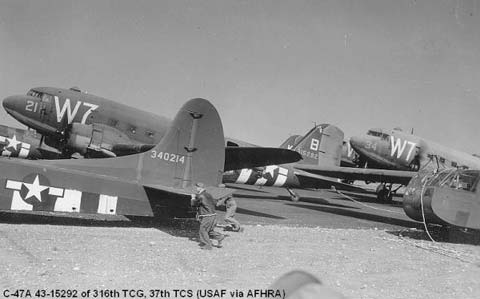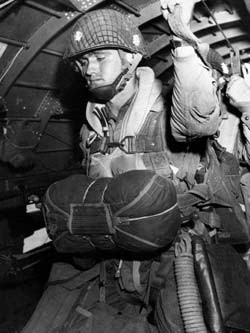Paratroopers boarded the Douglas C-47 Skytrain in England on a secret, dangerous mission: Jump behind enemy lines amidst fog and gunfire to seize bridges and halt a German advance from the west.
They jumped at a low altitude, weighed down by 90 to 120 pounds of gear. Some hit the ground so hard their supplies scattered into the pre-dawn darkness. If the Allied invasion at the Normandy beaches five hours hence failed, no one would come to rescue them.
Sitting on the Frederick Municipal Airport ramp in Frederick, Md., painted with the Normandy invasion stripes, a C-47 that dropped American paratroopers on D-Day paid quiet tribute recently to the men who risked—and gave—their lives in the decisive Allied invasion during World War II. The all-volunteer 1941 Historical Aircraft Group Museum of Geneseo, N.Y., flies the Gooney Bird to airshows and other events to bring history alive for young and old alike. “It’s a piece of flying history,” said Director of Flight Operations Naomi Wadsworth.

The museum’s aircraft has served in various military and civilian roles—including service in North Africa during World War II and use by airlines—but the group is working to restore it to what it would have looked like for its most historic mission. The Skytrain flew as the lead aircraft of the second wave of the 316th Troop Carrier Group on D-Day, dropping paratroopers from the 505th regiment of the 82nd Airborne division over the town of Ste. Mère Église. The interior, in an executive configuration when the aircraft was donated seven years ago, is now set up to carry paratroopers, with an open layout, a few canvas seats, and static line installed.
According to the U.S. Army, more than 13,000 paratroopers were flown from bases in southern England to the Cotentin Peninsula in close to 1,000 Skytrains for the airborne assault on D-Day, the largest use of airborne troops up to that time. The Allies incurred thousands of casualties in the invasion of Normandy that began June 6, 1944, but gained a foothold in France, leading to the liberation of the country and paving the way for an allied victory against the Nazis.
Wadsworth said a lot of young children at airshows love the airplane and are drawn to its beautiful, friendly design. Then, when they find out about its history and age—it was commissioned in the Army Air Forces in 1943—they’re amazed it still flies. A DVD playing on a screen at the back of the airplane explains the airplane’s role in the Normandy invasion, with a goal of drawing visitors into the vivid reality of a history that seems distant for many.
 With their parachutes and other gear, paratroopers weighed in at 90 to 120 pounds more than their body weight.
With their parachutes and other gear, paratroopers weighed in at 90 to 120 pounds more than their body weight.
For other visitors, the aircraft touches personal histories. Whether they loved flying a C-47 or DC-3 as a civilian, recall the sacrifices and triumphs of World War II, or served in the military in more recent conflicts, Wadsworth said the aircraft gets people talking. “I’ve heard a lot of stories over my 31 years of doing this,” said Wadsworth, whose family has long been involved in the volunteer effort to keep World War II history alive in Geneseo.
One afternoon as the C-47 sat in Frederick between appearances at Manassas Regional Airport’s airshow and the Andrews Air Force Base Joint Service Open House and Air Show, two World War II veterans and a woman whose brother died in France following the invasion talked about a time that left an imprint on their memories and earned them the designation of the Greatest Generation. Charles Bare, a former Army communications operator wearing a “World War II Veteran; Served with Pride” cap, told how he dropped leaflets and supplies from C-47s in the Philippines. The veteran had returned after an earlier visit to show 1941 Historical Aircraft Group representatives a photograph of himself in the Philippines with a Piper Cub; he had taken just enough instruction to land an aircraft in the event of an emergency, he said.
Wearing a T-shirt that read “Elderberries have more fun than Youngerberries!” former Marine Duke Klareich said he signed up at 18 and went to the island of Guadalcanal in 1944 before being wounded the following year. While he wasn’t a pilot in the service, the distinctive look of the World War II aircraft caught his eye from inside the airport restaurant.
The 1941 Historical Aircraft Group’s Gary Mitchell, who accompanied the aircraft to Frederick, said the visit was productive for the nonprofit, which sold T-shirts, books, and DVDs at the airplane and received donations. The organization operates a number of aircraft in addition to the Skytrain and relies on donations and paid memberships to support its operations. The museum also hosts an annual airshow at the grass-runway airport in Geneseo, billed as “The Greatest Show on Turf,” to showcase World War II and other military aircraft and honor veterans.
Wadsworth said of the group’s 900 members, a core group of about 100 volunteers helps out at the museum and airport, working on everything from mowing grass to building stairs and repairing tractors. Many serve in multiple roles, like Mitchell, who acts as chief financial officer and flight engineer, and put together the video for airshows. “Everybody brings a little bit different talent to what we’re doing,” said Mitchell. “… We’re not formal at all. We’re just a bunch of people that love airplanes.”


